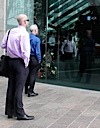The Adaptive City, an essay by Dan Hill
“However, these urban informatics do become manifest in the built fabric nonetheless; they have a potential physical presence, as the model is only partly concerned with drawing data from the city. It also feeds it back. Urban information design emerges in a call-and-response relationship with informatics, filtering and describing these patterns for the benefit of citizens and machines.
The invisible becomes visible, as the impact of people on their urban environment can be understood in real-time. Citizens turn off taps earlier, watching their water use patterns improve immediately. Buildings can share resources across differing peaks in their energy and resource loading. Road systems can funnel traffic via speed limits and traffic signals in order to route around congestion. Citizens take public transport rather than private where possible, as the real-time road pricing makes the true cost of private car usage quite evident. The presence of mates in a bar nearby alerts others to their proximity, irrespective of traditional spatial boundaries. Citizens can not only explore proposed designs for their environment, but now have a shared platform for proposing their own. They can plug in their own data sources, effectively hacking the model by augmenting or processing the feeds they’re concerned with.
If a group of interested parents suspect that a small playground added to the corner of their block might improve the health of their kids, with knock-ons for nearby educational facilities, cafés and the natural safety of a more active street, they can wrangle these previously indiscernible causal relationships into a prototype and test their new designs, garnering the requisite public engagement along the way.
Everyday design could become a conversation within social software networks, and citizens have data and tools that urban designers can only dream of. In fact, professional urban designers have this data too, and thus their practice is transformed.” […]
“The new technologies of urban informatics and city information modelling enable citizens to reflect on their city, engage in the design, adapt their behaviour and the city around them. It could well lead to a new understanding and a new respect, and so to a new city.”
Dan Hill is a senior consultant at the renowned and highly innovative engineering firm Arup. Prior to that, he was the director of web and broadcast at Monocle and the head of interactive technology and design at the BBC.
The essay will be published in the exhibition catalogue for Urban Play, a project Scott Burnham conceived and then developed with Droog Design.




